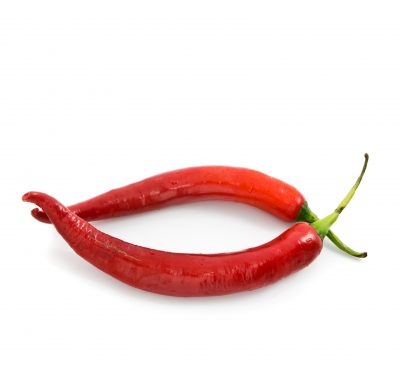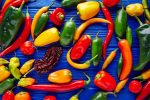
Red chili peppers are one of the most widely used spices in the world and an essential requirement in ethnic cuisine. The powder is a constituent of a number of spice mixes such as sriracha from the Far East or Bahārāt from the Middle East. Indeed its use is not only ever increasing but it is increasingly popular as a home-grown vegetable and we have discussed its cultivation for the home at length (see article).
Chilli (chile) (Capsicum annuum L.) is widely grown throughout most of the tropical and sub-tropical world but it also thrives under greenhouse conditions. The absolute requirement is for hot and humid conditions. Even in the UK or Northern Europe, chilli varieties are currently being developed though for colder, wetter conditions.
The fruit as it is really called also has many professed medicinal and general health properties (Tapsell et al., 2006; Kaefer and Milner, 2008).
Processing Chilli Powder
The powder is generated by crushing the whole chilli following washing and sorting. Most peppers are then dried usually under the sun or by convective hot air but there are many instances in both cases when poor postharvest management reduces the quality both in terms of its heat and flavour (Song et al., 2012). Sun drying needs a large, open space and very long drying times to be effective. It is known that the moisture content of fresh chili drops from 80% to 5% in 48 hours (Fudholi et al., 2014).
The combination of microwave and convective drying treatment is not effective even though it is possibly the quickest of all (Soysal et al., 2009).
A significant issue of any drying is contamination with bacteria such as Bacillus cereus, Clostridium perfringens and the mold Aspergillus flavus (de Boer et al., 1985). The most effective treatments to inactivate and even destroy bacteria such as Salmonella and Escherichia coli O157:H7 include chlorine dioxide (ClO2) (Choi et al., 2016). The application of the novel treatment cold plasma technology has not been so successful (Kim et al., 2013).
If you pretreat the chilli pepper by soaking the peppers in water, steam blanching to destroy micro-organisms and then soak in osmotic solutions of 60 and 70° brix., you see quicker drying. However, sun drying is so cheap it is likely continue to be the method of choice for years to go (Tunde-Akintunde, 2011).
If you are interested in knowing more about drying chilli or indeed any other spice contact FoodWrite Ltd as we can help resolve your issues.
References
Antai, S.P. 1988. Study of the Bacillus flora of Nigerian spices. Intl. J. Food Microbiol. 6 pp. 259–61
Cho, S.I., Bae, Y.M., Noh, D.H. (1997) Measurement of moisture and fat contents in pepper-powder using near-infrared spectroscopy. Food Engr. Prog. 1 pp. 133–6
Choi, S., Beuchat, L.R., Kim, H., Ryu, J.H. (2016) Viability of sprout seeds as affected by treatment with aqueous chlorine dioxide and dry heat and reduction of Escherichia coli O157:H7 and Salmonella enterica on pak choi seeds by sequential treatment with chlorine dioxide drying and dry heat. Food Microbiol. 54 pp. 127–32.
De Boer, E., Spiegelenberg, W., Janssen, F. (1985) Microbiology of spices and herbs. Anton Leuw 51 pp. 435–8
Fudholi, A., Sopian, K., Yazdi, M. H., Ruslan, M. H., Gabbasa, M., & Kazem, H. A. (2014). Performance analysis of solar drying system for red chili. Solar Energy, 99, pp. 47-54.
Kaefer, C.M., Milner, J.A. (2008) The role of herbs and spices in cancer prevention. J. Nutr. Biochem. 19: pp. 347–61
Kim, J.E., Kim, I.H., Min, S.C. (2013) Microbial decontamination of vegetables and spices using cold plasma treatments. Korean Soc. Food Sci. Technol. 45 pp. 735–41.
Song, Y.J., Park, S.W., Chun, S.C., Choi, M.J., Chung, K.C., Lee, S.K. (2012). Efficient treatment methods for reducing Escherichia coli populations in commercially-available red pepper powder in Korea. J. Korean Soc. Food Sci. Nutr. 41 pp. 875–80
Soysal, Y., Ayhan, Z., Eştürk, O., & Arıkan, M. F. (2009). Intermittent microwave–convective drying of red pepper: Drying kinetics, physical (colour and texture) and sensory quality. Biosystems Engineering, 103(4), pp. 455-463.
Tapsell, L.C., Hemphill, I., Cobiac, L., Patch, C.S., Sullivan, D.R., Fenech, M., Roodenrys, S., Keogh, J.B., Clifton, P.M., Williams, P.G., Fazio, V.A., Inge, K.E. (2006) Health benefits of herbs and spices: the past the present the future. Med. J. Australia 185 (4 Suppl.):S4–24.
Tunde-Akintunde, T. Y. (2011). Mathematical modeling of sun and solar drying of chilli pepper. Renewable Energy, 36(8), pp. 2139-2145


Leave a Reply